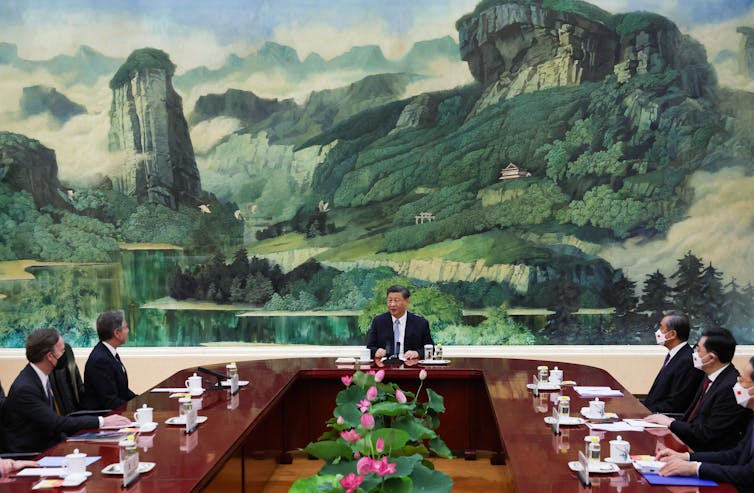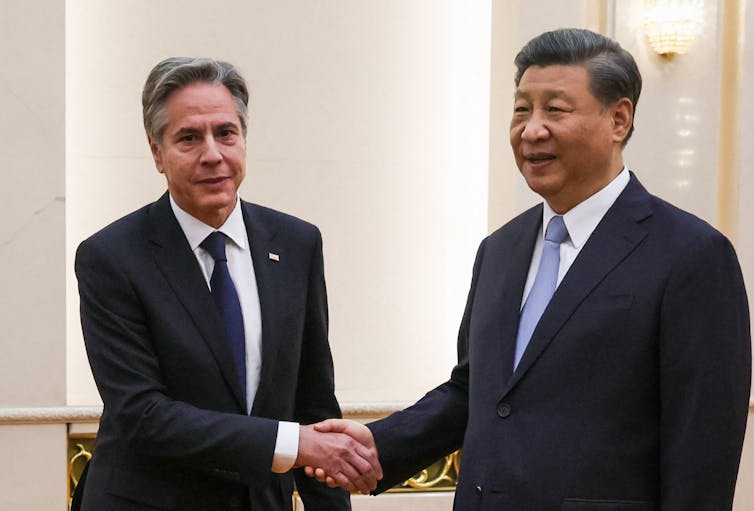China and the US are locked in struggle – and the visit by Secretary of State Blinken is only a start to improving relations

By Krista Wiegand, University of Tennessee
In the weeks building up to U.S. Secretary of State Antony Blinken’s visit to China on June 18-19, 2023, there was a lot of uncertainty in both the United States and China about the purpose and possible outcomes of the visit. When Blinken left Washington, D.C., it wasn’t even clear if he would be able to meet with Chinese President Xi Jinping. He did.
The meeting took place just two weeks after a Chinese naval vessel crossed within 150 yards of a U.S. destroyer, in what the U.S. military calls an “an unsafe maritime interaction” in the Taiwan strait. It was not an isolated incident. Three weeks before Blinken and Xi sat down, a Chinese fighter jet came dangerously close to a U.S. surveillance plane over the South China sea.
Not surprisingly, these two close interactions heightened tensions at a time when relations between the two countries were already strained.
President Joe Biden’s characterization of Xi as a dictator during a June 20, 2023, campaign fundraiser – just a day after Blinken returned to the U.S. – shows just how rocky the relationship is between the two countries. China is already reacting to the remarks, labeling them “extremely absurd and irresponsible.”
As a scholar of international relations specializing in Indo-Pacific security issues, I closely follow U.S-China relations, including territorial and maritime disputes.
The U.S. routinely sails ships and flies planes in the disputed waters and airspace in the South China Sea to indicate the right of free transit mandated by international law. But China claims both areas as its own territorial waters and denounces U.S. activities in what China sees as its domestic domain.
The bar was fairly low
The last visit by a U.S. secretary of state to China was in 2018, and dialogue has been limited on multiple levels since then. While the relationship between the U.S. and China has grown increasingly tense and uncertain for several years, the past year has seen the worst relations since diplomatic relations began in 1979.
Despite the continued economic connections between the two powers, political and security relations have soured dramatically. Both countries have repeatedly condemned each other for a variety of reasons, resulting in the current tensions.
While not likely to become another cold war, the U.S.-China relationship is certainly an intense rivalry. It is in this context that Blinken visited China.
The Blinken visit opened the lines of communication for the more serious talks the two countries must have in order to lower tensions. But in other ways, it was more symbolic and part of the tenuous, uncertain relationship between the world’s two most powerful countries.
The official reason for the trip was mainly to reestablish regular communication. But restarting regular communication, which Blinken and Xi said the countries are willing to do, made the talks a successful first step in the long walk back to diplomacy.
Now, the tedious work begins. Other U.S. officials such as Treasury Secretary Janet Yellen, climate envoy John Kerry and Secretary of Defense Lloyd Austin – whose request to meet with Chinese Defense Minister Li Shangfu at a security conference in Singapore in May 2023 was rejected by China – will be able to more easily meet with their counterparts. On their agendas will be issues ranging from concerns about imports and exports to avoiding armed conflict.

Growing list of issues
It will be a while before we know whether Blinken’s main goal of arranging a meeting between Xi and Biden later in 2023 was successful.
I believe the diplomatic visit was a good step toward addressing a growing list of bilateral issues that need attention. But it will take more time and require much more communication before a clearer picture of the status of the U.S.-Chinese relationship appears.
This will require continual dialogue, not the on-again, off-again meetings that have been happening in the past five years. Even then, while the U.S. government appears to be direct and transparent about its foreign policy – following through with stated policies in its actions – the Chinese approach to diplomacy is opaque and frequently features a disconnect between what is claimed versus what is done. The Chinese government rarely publicizes foreign policy documents, and speeches by government officials tend to be deliberately ambiguous and nonspecific. Uncertainty is the name of the game for at least one side in this rivalry.
Issues at stake
The list of bilateral issues and disputes between the two countries is extensive:
-
U.S. support for Taiwan, which China contends “seriously infringes upon China’s sovereignty and territorial integrity.”
-
Chinese territorial and maritime claims in the East China Sea and South China Sea conflict with the U.S. position that international law guarantees freedom of the sea.
-
China is angry over national security-based restrictions by the U.S. and several allies on the importation of Chinese-made semiconductor chips and exports of certain technologies to China.
-
U.S. condemnation of Chinese economic coercion in countries around the world – providing loans at low rates, then taking control of a port or other infrastructure when the country cannot repay the loan in time.
-
U.S. criticism of China’s human rights violations in Hong Kong, Tibet and Xinjiang.
-
The existing Chinese spy base in Cuba, which, according to The New York Times, might allow China to intercept electronic signals from U.S. military and commercial buildings.
-
Recent near misses between U.S. and Chinese vessels in the Taiwan Strait and South China Sea.
The overarching point of contention for the U.S. is China’s implied intention to displace the U.S. and become the world’s most powerful country. The current U.S. national security strategy names China as the most significant security challenge to the U.S. in our time.
China’s superpower ambitions
It’s a classic power struggle. The U.S. views China as a direct threat to its position as the lone superpower, with China attempting to replace the U.S.-led world order. The key questions are whether China will displace the U.S., when, and whether peacefully or by military force.
The speed of the Chinese military buildup over the past decade, both conventional and nuclear, is remarkable and daunting. While neither country wants a war, a potential military clash over Taiwan, in the East China Sea or the South China Sea could escalate, forcing U.S. officials to make difficult decisions about using force against China, which would have massive consequences felt around the world.
Even if diplomatic relations improve, the official U.S. national security strategy citing China as the most comprehensive and serious challenge to the U.S. will remain as the predominant foreign policy issue of our time. This is the century of a U.S.-China rivalry, with tensions being the only certainty of the relationship.
One visit by the U.S. secretary of state will not solve that problem.![]()
Krista Wiegand, Professor of Political Science, University of Tennessee
This article is republished from The Conversation under a Creative Commons license. Read the original article.



